
* Preliminary experiments have been performed on two particularly interesting concepts in spaceflight propulsion. "Lightsails" involve traveling between planets using a large lightweight reflective "sail" that captures light from the Sun or a large laser. "Lightcraft" involve blasting payloads into orbit on a column of laser or microwave energy. This chapter describes the lightsail and lightcraft concepts, and outlines progress in these fields.
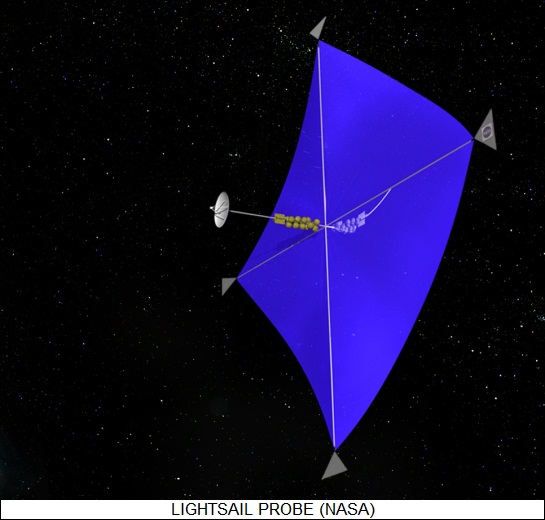
* Light is emitted in the form of particles called photons. Photons have momentum, and when they are reflected off a surface, they transfer momentum to that surface. In principle, if a spacecraft is tethered to a large reflecting surface, or "lightsail", sunlight falling on that surface would provide a gentle but continuous pressure that could propel the spacecraft between planets without any need to carry propellants for primary propulsion.
The concept of lightsail spacecraft has been around for decades. The first formal description of the idea was published in 1924 by the Russian spaceflight pioneer Konstantin Tsiokolvsky and his colleague, Friedrich Tsander. They wrote of "using tremendous mirrors of very thin sheets", and Tsander suggested that the sheets could be made of thin plastic covered by a metal thin film.
The basic principles that have guided design of lightsail spacecraft were first outlined by an engineer named Carl Willey. He published his ideas in an article written under the pseudonym "Russell Sanders" and published in ASTOUNDING SCIENCE FICTION magazine in May 1951. The idea attracted little attention until 1963, when British science fiction writer Arthur C. Clarke published a story titled THE WIND FROM THE SUN, which envisioned a lightsail race in space. The story was illustrated by the prominent space artist Bob McCall, and helped add lightsails to the long list of new space technologies investigated in the spacehappy enthusiasm of the early 1960s. Within a few years, some lightsail enthusiasts suggested using lasers or possibly microwave beamed power stations to give a lightsail a boost.
In 1976, NASA JPL conducted studies on a lightsail space probe to fly by Halley's Comet during its return to the inner solar system. They considered an 850-kilogram spacecraft, propelled by a square sail 800 meters on a side. The concept was too ambitious and the studies were quickly shelved.
* NASA's disillusionment with lightsails was not unreasonable, since there are serious practical obstacles to actually one that works. The problem is that the pressure of sunlight is very slight, which means that a very large reflecting surface of very little mass is required. This has a number of troublesome implications:
Interest in lightsails began to revive in the late 1980s. There have been a number of interesting designs that attempt to address the control, packaging, and deployment issues, including the "kite", "fan", "sunflower", and "heligyro" lightsail configurations.
In the kite configuration, the sail is strung along spars in the form of a cross, with the spacecraft module in the center. The kite is launched with one spar fixed and the sail material folded to it. Once in deployment orbit, the other spar is extended, segment by segment, to unfold the sail. Small triangular fins are deployed at the corners of the kite to provide attitude control.
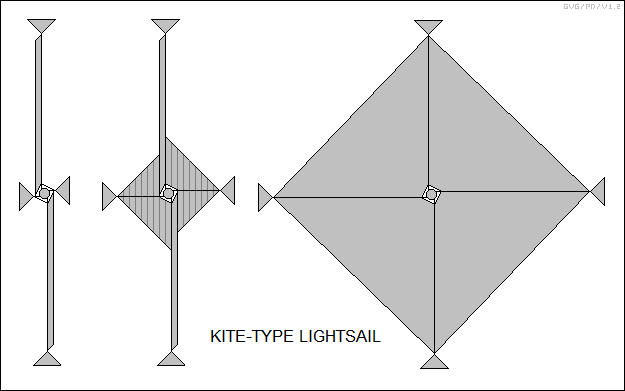
In the fan configuration, a disk-shaped sail is supported by radial spokes, with the spacecraft module at the hub. At launch, the sail material and the flexible spokes are coiled around the hub, and then unfurl when in deployment orbit. The spacecraft module controls the sail with motors that adjust the position of the spokes.
In the sunflower configuration, the sail is supported by a hoop around the edge, with the spacecraft module connected to the sail by a tether at the center and linked by guy wires to the hoop. The hoop is made of sections that are connected end to end, and folded in a zigzag fashion before launch. Once in deployment orbit, the hoop unfolds and spreads out the sail. The spacecraft module uses the guy wires to control the orientation of the hoop.
These three schemes require a support structure that adds weight, but adds little or nothing to propulsion in itself. The heligyro configuration is unusual in that it requires no structural support. In the heligyro, the sail is in the form of multiple long, narrow blades that are simply unrolled away from the central spacecraft module. The entire spacecraft spins to keep the blades straight. The spacecraft module can pivot the blades to provide attitude control, though the heligyro's maneuverability is relatively limited. The configuration is most appropriate for deep-space flyby missions, where maneuverability is not a high priority.
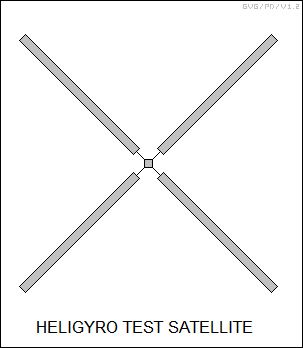
* Practical experience with deploying such large structures in space is very limited. In 1993, a Russian Progress supply spacecraft used an electric motor to deploy a flexible mirror 20 meters in diameter. The mirror was intended to test the design of large mirrors that could be put into orbit to provide more sunlight for Russia's northern regions in the winter. A second mirror test using another Progress failed when the mirror couldn't be deployed.
Experiments in inflatable spacecraft structures have obvious applications in lightsail spacecraft technology. In May 1996, the NASA space shuttle deployed an experimental inflatable radio antenna. The experiment was not entirely successful; work on space inflatables and other deployable structures continues at a low level.
BACK_TO_TOP* In the early 1990s, a private group tried to promote a lightsail race in which commercial sponsors would send lightsail spacecraft to Mars. Nobody bit, but a privately-funded Russian-American effort later attempted to perform the first space tests of lightsail technology.
The "Cosmos 1" program was directed by the US Planetary Society, which has a long tradition of contacts with Russian space organizations. The Russian Babakin Space & Research Center built the experimental lightsail spacecraft, and also handled the launches. Electronics systems were implemented by the Russian Space Research Organization. Funding, on the order of several million USD, was formally provided to the Planetary Society by Cosmos Studios INC, which was set up by Ann Druyun, widow of Dr. Carl Sagan, the society's co-founder. The money was actually provided by Joseph P. Firmage, an Internet entrepreneur who founded the USWeb company.
The 40-kilogram Cosmos 1 spacecraft was a hybrid design, with features of both the sunflower and the heligyro configuration. It consisted of eight triangular panels connected to a central hub, with each panel supported by inflatable tubing around its edge. Each petal was about 15 meters long, giving the deployed satellite a diameter of 30 meters, and the sail material consisted of aluminized mylar 5 microns (millionths of a meter) thick. A cold gas thruster system was used to "spin up" the spacecraft to 95 RPM to aid deployment. Each petal could be rotated from the hub to change the direction of thrust.
* The initial plan was to launch a suborbital deployment test, followed by a full orbital mission. The deployment test was to feature a spacecraft with only two petals and carrying a camera to observe deployment. Telemetry was not implemented, with the camera parachuted back to Earth on a re-entry vehicle.
The full flight test envisioned launch of the Cosmos 1 spacecraft into a circular orbit with an altitude of 850 kilometers, at an inclination of 78 degrees. The satellite was expected to obtain an acceleration of 10 meters a day under optimum conditions, and was fitted with a sensitive accelerometer to observe the actual levels of acceleration. After a few weeks of learning how to control the spacecraft, lightsail pressure was to be used to raise its orbit.
Another element of the test flight was to beam microwave power on it from the NASA 70-meter-diameter Deep Space Network antenna at Goldstone, California, to determine how beamed power might be used to boost the lightsail. Incidentally, ground tests of using microwave power to drive lightsail material demonstrated substantially more thrust than expected, with the reason finally determined to be that the beamed power was causing the lightsail to outgas materials. Lightsail researchers have expressed interest in the idea of actually building lightsails that take advantage of this "rocket" effect for initial boost.
The flights were expected to last at least three months. The missions were to be launched by a Russian "Volna" booster, a modified "SS-N-18" submarine-launched ballistic missile, shot from a Russian "Kalmar / Delta III" class submarine from the Barents Sea.
The first suborbital test shot was on 20 July 2001. Unfortunately, due to the failure of the booster's third stage, the Cosmos 1 spacecraft was never deployed, dooming the mission. That was disappointing, but valuable experience had been gained in setting up the mission and there had been no problem with the spacecraft as such. The second shot, on 21 June 2005, was to put a sail into full orbit, but once again there was a booster failure and the payload fell back to Earth.
The first successful deployment of a solar sail was actually performed by the Japanese JAXA space agency. On 20 May 2010, a JAXA H2A booster was launched from Tanegashima island to send the "Akatsuki" orbiter probe to Venus; the Venus orbiter was accompanied by the JAXA "IKAROS" solar-sail test spacecraft. IKAROS stood for "Interplanetary Kitecraft Accelerated by Radiation of the Sun". IKAROS had a launch mass of 300 kilograms, and deployed a square solar sail measuring 20 meters on the diagonal. After deployment, the spacecraft ejected a small camera pod to inspect the sail. IKAROS was placed on the same trajectory as Akatsuki, though it did not go into Venus orbit.
The second successful deployment of a sail spacecraft was early the next year, though it initially seemed to be a failure. On 19 November 2010, a US Air Force Minotaur booster was launched from Kodiak Island in the Aleutians to put a set of smallsats in orbit. One was a NASA satellite named "FASTSAT" that carried miscellaneous test payloads, including a small sail experiment in the form of a "triple CubeSat" -- essentially three CubeSats in a stack -- named "NanoSail D", with a square sail measuring 9.3 square meters.
Unfortunately, it got stuck in its dispenser when the attempt was made to launch it. Much to everyone's surprise, it popped out on 17 January 2011 and deployed properly three days later. It was actually a backup spacecraft; the first Nanosail D had been lost in the launch failure of a Falcon 1 booster in 2008.
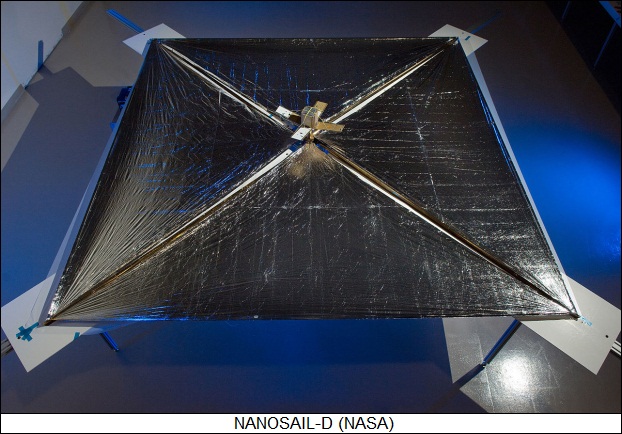
Nanosail D was not intended to demonstrate a propulsion system. The concept was that a satellite could deploy such a sail to set up a slight drag from the traces of gas in near-Earth space that would cause its orbit to decay, preventing the buildup of "space junk" in Earth orbit. Of course, Nanosail D could also use the sail for propulsion and maneuvering; it suggests the possibility that such vehicles could rendezvous with old dead spacecraft, latch or harpoon onto them, and force them to fall out of orbit. Nanosail D has been followed by a number of nanosats with similar dragsail de-orbiting technologies.
* Despite the problems with Cosmos 1, the Planetary Society didn't give up. By 2010, the Planetary Society had, unsurprisingly, rethought the solar sail effort, focusing on a demonstrator, "Lightsail 2", also a triple CubeSat spacecraft and deploying a square lightsail. The spacecraft will have a weight of 4.5 kilograms, with the sail made of aluminized mylar 4.6 microns thick and measuring 5.5 meters on a side. The nanosat will have a flight control and communications system, along with a video camera to monitor the sail deployment.
A small technology demonstrator named "Lightsail A", later renamed "Lightsail 1", was launched on an Atlas 5 booster on 20 May 2015, the demonstrator being one of a clutch of nanosats accompanying the flight of an Air Force X-37B robot spaceplane. Lightsail 1 had nothing but trouble after being placed in orbit, with communications lost several times, but it finally deployed its solar sail on 7 June. It was in low orbit and re-entered a week later.
Lightsail 2 was launched on 25 June 2019, as a secondary payload on the second operational flight of the SpaceX Falcon Heavy booster -- the primary payload being the US Air Force "STP 2" payload. Its sail was deployed a month later, and was used successfully to raise the satellite's orbit, although it spent a considerable amount of time just tumbling.
Two more LightSail spacecraft were planned as follow-ons, with the final "Lightsail 4" to use its lightsail to place itself in solar orbit, where it would observe solar activity to keep an eye on "space weather". Lightsail 4 was to be an operational spacecraft, not merely a demonstrator like its predecessors, that could pave the way for using nanosatellite technology on low-cost deep space missions. However, activity on the Lightsails has gone quiet.
* However, NASA has continued to fly lightsail missions. The "Near-Earth Asteroid (NEA) Scout" mission was a demonstrator for a mission to visit asteroids passing near the Earth. NEA Scout was based on a six-unit CubeSat, about the size of a box of breakfast cereal, and could deploy four 7-meter booms, which supported an aluminized polymide solar sail with an area of 83 square meters. Unfortunately, communications could not be established following its launch on 16 November 2022.
A similar NASA mission, "Advanced Composite Solar Sail System (ACS3"), flew in April 2024. It was a 12-unit CubeSat, about the size of a small microwave oven. Its primary goal was to demonstrate composite sail booms, which retain their rigidity in space better than metal booms.
BACK_TO_TOP* Lightsail technology remains experimental, with little interest at present in regular operational use. One aspect of the technology that definitely needs work is sail material. Aluminized mylar works okay for the time being, but it isn't the best material for building a lightsail, since solar ultraviolet radiation gradually breaks it down. Lighter and more durable materials are required.
A mission to Mercury could be conducted by a lightsail spacecraft with a sail 100 meters on a side and a density of less than 10 grams per square meter. However, really making use of lightsail technology requires a material with a density of less than 5 grams per square meter, and lightsail enthusiasts regard a density of 1.5 grams per square meter as the target of their work. NASA JPL has conducted modest research on lightsails, with much of the effort focused on improved materials.
With such advanced sail materials, lightsail spacecraft with sails measuring about 200 meters on a side could be placed in orbits to observe the poles of the Sun, and perform flyby missions of the outer planets. For outer planet missions, a lightsail spacecraft would loop in towards the Sun, approaching about as close as the orbit of Mercury, and use its sail to obtain a strong boost from the intense solar radiation. The spacecraft would then arc out into deep space, discarding the sail once it reached the orbit of Jupiter, since sunlight pressure is too weak beyond that boundary to be useful.
NASA has organized discussions of a lightsail mission that would fly beyond the planets. The Interstellar Probe would be sent outside "heliopause", the boundary of our solar system, to a distance of 200 astronomical units (AU, where one AU is the distance from Earth to Sun), where it would perform studies of the interstellar medium. The discussions have also considered a more ambitious Interstellar Probe mission that would carry a telescope to a distance of 550 AU from the Sun, where it could use the Sun as a "gravitational lens" to perform high-resolution observations of distant cosmic objects.
The next step beyond sending a lightsail spacecraft into interstellar space is a journey all the way to a nearby star. A NASA investigation conducted in 1998 concluded that a lightsail spacecraft was the only technology that was close enough to practical development to be considered for such a mission. However, a lightsail star probe is still a significant technical challenge. The sail material would have to be extraordinarily light, the sail would have to be very large, and since the Sun's light becomes insignificant for propulsion beyond the orbit of Jupiter, the lightsail would have to be driven by a laser array of unprecedented size and power. This scenario is discussed in more detail later.
* An interesting variation on the lightsail concept, known as the "magsail", was proposed by two aerospace engineers, Dana Andrews and the well-known Robert Zubrin. Instead of using a large reflective sail to catch solar photons, the magsail would use a loop of superconducting cable, as large as 30 kilometers in diameter, to generate a magnetic field that would catch solar wind particles. The advantage of the magsail is that it could obtain 50 times more propulsive effect than a comparable lightsail. The disadvantages are that it requires a huge superconducting cable, which is not practical at present, and an energy source to set up the magnetic field.
A team led by Robert Winglee of the University of Washington has proposed a different form of magsail, with the name "mini-magnetospheric plasma propulsion (M2P2)". Instead of a huge superconducting magnet, M2P2 involves a spacecraft with a large magnetic coil that generates a magnetic field around the spacecraft. Plasma is injected into the magnetic field, causing it to expand into a large tenuous magnetic field, possibly 40 kilometers across, that traps solar wind particles. In principle, M2P2 can be built with existing technology, though it does require power for the coil and a small quantity of gas as a source of plasma.
There are also proposals for an "electric sail" technology that also rides the solar wind, but uses an electric field instead of a magnetic field to catch the wind. The idea was first proposed in 2006 by Pekka Janhunen of the Finnish Meteorological Institute.
The electric sail envisions a space vehicle with a set of radially-deployed conductive tethers, positively charged to repel negatively-charged solar-wind particles. Selectively adjusting the voltage on tethers provides directional control. An operational sail would have 50–100 tethers with a length of about 20 kilometers, with the tether array being spun to keep the tethers straight.
The Estonian ESTCube 1 CubeSat, launched in 2013 and mentioned earlier, attempted to test the concept, but the single tether failed to deploy. NASA has funded a study, the "Heliopause Electrostatic Rapid Transit System (HERTS)", for a probe to fly to the heliopause, the declared boundary of the Solar System, a hundred times the distance of the Earth from the Sun.
BACK_TO_TOP* If lightsails are a subtle means of propulsion, lightcraft are very much the opposite, involving payloads launched into space on an intense beam of light. The concept of the lightcraft owes much to one man, Leik Myrabo, an associate professor of mechanical engineering at the Rensselaer Polytechnic Institute (RPI) in Troy, New York. During the 1980s, Myrabo's interest in using a powerful laser to boost spacecraft into orbit progressed until by 1990 he and his colleagues at RPI were investigating concepts in detail, with backing from NASA and the Strategic Defense Initiative Organization (SDIO).
According to Myrabo, such a laser-boosted launch system offers much lower launch costs than a chemical rocket system. Since the spacecraft obtains most of its propulsive energy from external sources, a larger part of the spacecraft can be devoted to payload instead of fuel. Since the spacecraft doesn't incorporate a large high-thrust rocket motor, it also is potentially more reliable.
* Myrabo's initial concepts were based on lightcraft propelled by a large laser. Early experiments envisioned ground-based lasers, but long-range concepts considered the use of orbiting lasers, built as part of a solar power satellite (SPS) system.
The first designs for laser lightcraft defined a cone-shaped spacecraft, surrounded near its base by a ring shroud. Lightcraft designs propelled by a ground-based laser have a spindle-shaped baseplate, while those propelled by an orbiting laser have a flatter baseplate. In either case, the lightcraft carries a relatively small fuel load of hydrogen, as well as typical spacecraft systems such as control electronics, communications, attitude-control thrusters, and so on.
Lightcraft operating scenarios varied, but in a representative scenario using a ground-based laser, a lightcraft begins its flight by being catapulted into the air by a compressed-air charge. Laser light is shined onto its bottom, and the reflective ring shroud focuses the light to below the tip of the baseplate spindle. The focused energy is so intense that the hot air ionizes, creating a plasma arc that explodes outward and blasts the lightcraft upward at very high acceleration until the lightcraft reaches about Mach 1. At this speed, air is flowing over the conical front of the spacecraft, compressing the airflow and directing it into the ring shroud. The lightcraft then begins operating as a type of ramjet engine, with the conical spacecraft front acting as the ramjet centerbody, and the ring shroud acting as the ramjet duct.
For ramjet operation, the configuration of the shroud is adjusted to focus the laser light onto "igniters" underneath the ring that energize the air flowing into the shroud into plasma, providing thrust for the lightcraft. As the lightcraft accelerates to Mach 11, the ramjet operates in various "pulsed detonation" modes, in which thrust is obtained through a train of plasma explosions. During this flight phase, the airflow through the ramjet duct shifts from subsonic to supersonic, with the lightcraft then operating as a "supersonic combustion ramjet (scramjet)".
Above Mach 11, the lightcraft uses magnetic fields to compress the intake air, and injects hydrogen into the plasma flow to maintain thrust. Power for magnetic field generation is obtained directly from the intense plasma flow over the lightcraft through "magneto-hydrodynamic (MHD)" principles. MHD electrical power generation is conceptually simple, though difficult to achieve in practice because of the extreme nature of hot plasmas. A plasma is an ionized gas, consisting of free electrons and positive ions. If this plasma flows through a magnetic field, the electrons and positive ions are driven apart, creating an electrical potential difference. If an electrical circuit connection is placed at the edges of the plasma stream, electrons flow as a current through the circuit's load and then recombine with the positive ions on the other side of the circuit. The lightcraft MHD system generates large amounts of electric power, enough to produce strong magnetic fields to control the raging plasma flow.
By the time the lightcraft reaches an altitude where there is not enough atmosphere to sustain an air-breathing engine, it has a speed of Mach 25. It then uses a laser-powered rocket engine, with hydrogen exhaust heated by the laser beam back on the ground, for final orbital injection.
Scenarios envisioning the use of an orbiting laser instead of a ground-based laser were similar, except that of course the light was shined down on top of the lightcraft. The design was modified accordingly to allow reflection of the beam through the ring duct to a center point below the baseplate. Lightcraft designs imply the development of extremely precise and high-quality mirrors. If more than the smallest fraction of the intense laser light were absorbed by the lightcraft rather than reflected, the lightcraft would be incinerated immediately.
* Myrabo and his colleagues understood that the lightcraft was a long-range concept, and focused their research on basic physics and technology, hopefully leading up to small-scale demonstrations. They managed to show that a lightcraft system could produce thrust, but the US Strategic Defense Organization abandoned work on a 100-megawatt (MW) laser system that was needed for practical operation. That left the laser option a dead end for the short run. Myrabo was undiscouraged, however, and joined with Yuri Raizer of the Russian Academy of Sciences to pursue another option: microwave power.
BACK_TO_TOP* High power microwave (HPM) transmitter arrays are much more practical than high power lasers at present, and so HPM seemed like a better option for the short term. Myrabo and Raizer obtained funding from the US Space Studies Institute (SSI) to conduct studies. Their concepts for HPM lightcraft had much in common with those devised for the laser lightcraft.
HPM lightcraft development concepts focused on a ground-based microwave transmitter array, instead of a more ambitious microwave satellite power system. Early concepts for HPM lightcraft were basically an evolution of the laser lightcraft concept. The major difference was that instead of using reflectors to manipulate laser power, the HPM lightcraft uses an antenna array to transform microwave energy into propulsive power.
In this concept, the bottom surface of the HPM lightcraft is embedded with a large number of vertically-oriented wires, each acting as a receiving dipole, and tuned to the HPM transmitter wavelength. This "super-igniter array" absorbs the microwave energy and generates enough heat to ionize the atmosphere underneath, creating a plasma blast to drive the spacecraft upward.
Much like the laser lightcraft, at higher speeds the microwave energy sustains pulsed operation through the HPM lightcraft's ring duct. At high altitudes, an auxiliary orbiting microwave beam satellite heats hydrogen to provide pure rocket propulsion. An alternate scenario envisioned a self-contained chemical rocket for propulsion out of the atmosphere.
* In the SSI studies, Myrabo envisioned launching a network of very small "microsats" using microwave energy. Large numbers of microsats would be put in orbit to construct orbiting communications, earth resources mapping, weather observation, or military reconnaissance networks.
HPM microsat concepts envisioned a spacecraft weighing only 15 kilograms unfueled, including a 3-kilogram payload. Hydrogen fuel capacity was 15 kilograms of hydrogen fuel at launch, for a total launch mass of 30 kilograms. The microsat was built with lightweight carbon composites, with a temperature-resistant silicon carbide overcoat to protect the spacecraft. Subsystems included a 75-watt solar panel, rechargeable battery, communications and guidance electronics, magneto-optic data storage, and attitude control and pointing system.
The ground-based HPM array required to launch this microsat was 550 meters in diameter and operated at 220 GHz, a band where the atmosphere is mostly transparent to microwave energy. Beam power was 30 MW, with a maximum range of 500 to 800 kilometers.
* HPM design concepts didn't stop there, however. Later work was more radical. Advanced HPM lightcraft were disk-shaped, resembling 1950s flying saucers, though in most concepts they flew top-first, not sideways like a frisbee.
Scenarios for such advanced HPM lightcraft involved energy provided by orbiting power satellites. The lightcraft converted the microwave energy into useful power with "rectifying antennas (rectennas)", and had a ring of superconducting magnets underneath its rim to generate intense magnetic fields to control air and plasma flow, eliminating the need for a ring duct. Electrodes were also arranged around the edge of the disk to obtain MHD power from plasma flow.
The lightcraft overcame the air resistance that would seem unavoidable in a top-first flight configuration by focusing some of the microwave energy above the spacecraft. The plasma generated acted as an "aerospike", creating a shockwave cone to divert airflow around the lightcraft. Myrabo and his group considered alternate scenarios for such HPM lightcraft, such as high-speed air transport.
* Despite all this effort, Myrabo's lightcraft remained mostly a paper project, with small-scale physics experiments conducted to demonstrate the feasibility of various features of the scheme. However, in 1996, Myrabo once again obtained US military funding to actually fly small lightcraft models, working in conjunction with Franklin B. Mead of the US Air Force Research Laboratory (AFRL). The AFRL sponsored small-scale tests of lightcraft propulsion at White Sands Missile Range, using a US Army 10-kilowatt pulsed carbon-dioxide laser. The tests were performed on beautifully machined solid aluminum models, ranging from 10 to 15 centimeters across and weighing about 50 grams.
Each laser lightcraft model resembled an acorn with a cone grafted onto its cap. A model was spun up with a nitrogen gas jet before launch to keep it stable in flight, and then kilojoule laser bursts, pulsed at a rate of 28 times per second, were fired on its bottom shield. The shield focused the light to ionize the air at the bottom of the lightcraft into a plasma, blasting the model upward.
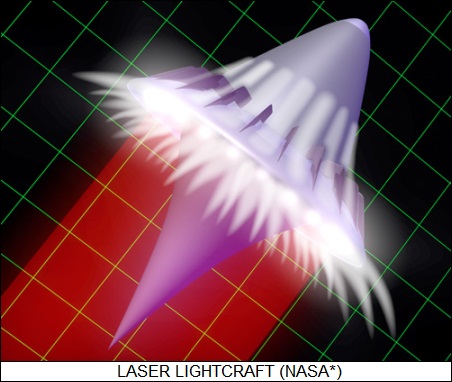
Initial flights were performed with a guide wire. The first free flight was performed in November 1997, and was followed by others that successively pushed the lightcraft higher and higher, though the limit was about 30 meters because of range safety problems. The research team was hoping to obtain a more powerful laser for more aggressive flight tests, but the effort then went quiet and hasn't been heard from again. Some conspiracy enthusiasts suspect that the US government may have developed microwave lightcraft, suggesting that sightings of such machines are linked to UFO incidents.
BACK_TO_TOP* Freeman Dyson described an interesting extension of lightsail and lightcraft spacecraft, which he called the "space butterfly".
It is likely that humans will eventually be able to manipulate the genetics of any organism, and even create new organisms where the distinction between organism and machine is blurred. While "living machines" are a fairly common gimmick in science-fiction stories, Dyson specifically envisioned the development of a microspacecraft based on the butterfly.
His space butterfly would be born and raised on Earth as a caterpillar, and at the end of that phase of its life cycle would weave itself into a tough cocoon. The cocoon could then be blasted into space on a small laser. Once in orbit, the space butterfly would break out of the cocoon and spread its wings, which would operate as lightsails.
The space butterfly's eyes would be little telescopes, its antennas radio aerials, its long springy legs optimized for clinging to and wandering over small asteroids, and its mouth full of chemical sensors for sampling the minerals on such asteroids and the solar wind. It would have a brain optimized for its mission, and built-in sensors to allow it to navigate. Dyson optimistically believed such technology would be available in a few decades. While the timescale is arguable, it's certainly a very entertaining idea.
BACK_TO_TOP